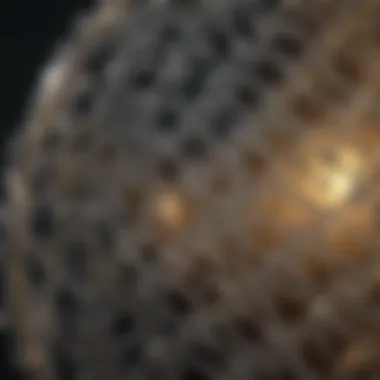Unveiling the Intricacies of Crystal Identification: A Journey of Discovery and Enlightenment


Rock and Fossil Identification
In the vast and captivating realm of crystal identification, understanding the nuances of rocks and fossils is paramount. As collectors delve into this world, they encounter a diverse array of rocks and fossils, each with its own unique characteristics and properties. From igneous to sedimentary to metamorphic rocks, the variations are endless, offering a treasure trove of exploration for enthusiasts. Fossils, the remnants of ancient life forms preserved in stone, provide a fascinating glimpse into Earth's history, showcasing the wonders of evolution and extinction.
When engaging in the identification process, collectors must keenly observe certain characteristics that distinguish one crystal from another. Factors such as color intensity, crystalline structure, hardness, cleavage, and luster all play a pivotal role in pinpointing the identity of a crystal. By honing in on these distinguishing features, enthusiasts can unravel the mysteries held within each mineral specimen, unlocking a deeper appreciation for the beauty and complexity of crystals.
To aid in this meticulous process, an arsenal of tools for identification becomes indispensable. From handheld magnifying glasses to specialized mineral testing kits, collectors rely on an array of instruments to analyze physical properties and conduct chemical tests. By harnessing the power of these tools, enthusiasts can navigate the intricacies of crystal identification with precision and confidence. With every rock and fossil holding a unique story within its structure, the journey of identification becomes a kaleidoscopic adventure of discovery and enlightenment.
Exploring the World of Crystals
In the realm of geological studies and mineralogy, delving into the vast and diverse world of crystals holds a significant allure and scientific intrigue. Crystal exploration goes beyond mere admiring their beauty; it involves a deep understanding of their formation, properties, and significance. In this article, we embark on an enlightening journey to uncover the mysteries of crystal identification. By shining a light on the fundamental aspects of crystals, we aim to provide rock and fossil collectors with valuable insights into distinguishing and appreciating these natural marvels.
What Defines a Crystal?
Crystals are not just exquisite geological formations; they embody precise structural arrangements that set them apart from other minerals. The structural makeup of crystals reveals a symmetrical order at the atomic level, exhibiting repeating patterns that contribute to their unique optical and physical properties. Understanding the structural composition of crystals is crucial in crystallography and mineralogy, as it allows for accurate identification and classification. This section delves deep into exploring the intricate patterns and arrangements that define the essence of crystals, shedding light on their inner workings and external manifestations.
The Structural Makeup of Crystals
The structural makeup of crystals is a harmonious interplay of atoms arranged in a specific geometric configuration, forming distinct lattice structures. This orderly arrangement gives crystals their well-defined shapes and crystallographic faces, making them readily recognizable. One key characteristic of the structural makeup of crystals is their ability to exhibit crystal systems, such as cubic, tetragonal, or hexagonal, based on the arrangement of their lattice points. This systematic arrangement not only influences the external appearance of crystals but also determines their optical properties and cleavage planes. The precision and repeatability of crystal structures make them integral in various scientific fields, from materials science to geology.
The Role of Atomic Arrangement
The role of atomic arrangement in crystals is paramount in defining their physical and chemical properties. The precise positioning of atoms in a crystal lattice governs attributes like hardness, transparency, and even color. Depending on the type of crystal structure, whether it's ionic, covalent, or metallic, the atomic arrangement plays a crucial role in influencing their behavior under different conditions. For instance, in ionic crystals, the arrangement of positively and negatively charged ions contributes to their brittleness and conductivity properties. Understanding the role of atomic arrangement in crystals allows scientists and collectors to interpret their characteristics accurately and appreciate the intricate nature of these geological wonders.
Types of Crystals
Crystals come in various forms and compositions, each exhibiting unique properties that define their classification and geological significance. Exploring the different types of crystals unveils a world of diversity and complexity, offering insights into their formation processes and material properties. By categorizing crystals based on their chemical bonding and atomic arrangements, we can decipher their characteristics and potential applications, enriching our understanding of the vast crystal kingdom.
Ionic Crystals
Ionic crystals are characterized by a strong electrostatic attraction between positively and negatively charged ions, leading to stable crystal structures with distinct cleavage planes. The key characteristic of ionic crystals lies in their brittle nature and high melting points, attributes derived from the ionic bonding within their lattice structures. This type of crystal is popular in mineralogy for its captivating symmetry and ability to display vibrant hues due to selective absorption of light. While ionic crystals exhibit impressive optical properties, their fragility poses challenges in handling and mounting for scientific analysis.
Covalent Crystals


Covalent crystals showcase a shared electron pair between atoms, creating strong bonds that result in exceptionally hard and durable materials. The key characteristic of covalent crystals is their resilience and heat resistance, making them ideal for industrial applications requiring robust structures. Their unique feature lies in the formation of interconnected tetrahedral units, leading to a three-dimensional network that enhances their stability. While covalent crystals excel in hardness and clarity, their limitations include limited color variety and challenging growth processes in synthetic crystal production.
Metallic Crystals
Metallic crystals boast a sea of delocalized electrons flowing freely among metal cations, presenting unique properties like conductivity and malleability. The key characteristic of metallic crystals is their ability to conduct heat and electricity due to the mobility of the free electrons within their structures. This feature makes metallic crystals valuable in technological applications where electrical conduction is essential. The unique feature of metallic crystals lies in their lustrous appearance and ductile nature, allowing for shaping and molding into various forms. While metallic crystals offer versatility in manufacturing processes, they may be prone to corrosion and tarnishing under certain environmental conditions.
Crystal Identification Methods
Identifying and characterizing crystals require a systematic approach that involves analyzing their physical, optical, and chemical properties. Various methods and techniques are employed to unravel the mysteries concealed within crystal specimens, enabling researchers and collectors to perform accurate assessments and classifications. By adopting a multifaceted approach to crystal identification, we can decode the hidden secrets of crystals and appreciate their intrinsic beauty and geological significance.
Physical Characteristics Analysis
Physical characteristics analysis involves examining the external features of crystals, such as shape, color, luster, and cleavage properties, to discern their mineralogical attributes. The key characteristic of physical characteristics analysis is its non-destructive nature, allowing for detailed observations without altering the crystal's structure. This method is popular among collectors and researchers for its simplicity and accessibility, providing valuable insights into the identification and classification of crystal specimens based on their visual properties.
Optical Properties Examination
Optical properties examination focuses on studying how crystals interact with light, revealing information about their transparency, birefringence, and pleochroism. The key characteristic of optical properties examination is its ability to uncover hidden features of crystals under polarized light, showcasing unique optical effects like interference patterns and extinction positions. This method is essential in mineralogy for identifying crystal species and distinguishing between similar-looking minerals based on their refractive indices and crystallographic orientations.
Chemical Composition Testing
Chemical composition testing involves analyzing the elemental composition of crystals through various laboratory techniques like X-ray fluorescence and spectroscopy. The key characteristic of chemical composition testing is its ability to determine the presence of specific elements within crystal samples, offering insights into their geological origins and formation processes. This method is invaluable in distinguishing between mineral species with similar physical properties but distinct chemical signatures, aiding in precise identification and classification of crystal specimens based on their elemental makeup.
Understanding Crystal Formations
In the realm of crystal identification, understanding crystal formations plays a pivotal role in unraveling the mysteries that lie within these precious geological treasures. Delving into the geological origins of crystals provides enthusiasts and collectors with valuable insights into how these mesmerizing formations come into existence, shaping their unique characteristics and properties. By exploring the intricate processes of crystal formations, individuals gain a deeper appreciation for the complexities of nature and the wondrous world of crystals.
Geological Origins of Crystals
Formation in Igneous Rocks
The formation of crystals within igneous rocks stands as a fundamental aspect of geological origins in crystal identification. Igneous rocks, born from the intense heat and pressure beneath the Earth's surface, give rise to a diverse array of crystals showcasing various colors, textures, and structures. The key characteristic of crystal formation in igneous rocks lies in their rapid cooling process, which enables the formation of distinct crystal lattices and compositions. This rapid cooling results in fine-grained textures and sometimes larger crystal formations, enhancing the aesthetic appeal and scientific value of these crystals within the realm of crystal identification. While igneous rocks may pose challenges in precise crystal identification due to the rapid crystallization process, their unique features provide enthusiasts with a rich tapestry of crystals to explore and study.
Deposition in Sedimentary Layers


The deposition of crystals in sedimentary layers unveils a different facet of crystal origins essential for comprehensive crystal identification. Sedimentary rocks, formed through the accumulation and cementation of sediments over time, serve as hosts to a multitude of crystal types shaped by environmental factors and geological processes. The key characteristic of crystal deposition in sedimentary layers lies in the gradual evolution of crystal structures within layered formations, reflecting the sedimentary history and earth movements that define these crystals' signatures. This slow development process allows for the preservation of delicate crystal features and enables the observation of crystal growth patterns influenced by external factors, making crystal identification within sedimentary layers a captivating journey of exploration and discovery.
Crystallization in Metamorphic Processes
Crystallization through metamorphic processes introduces a fascinating dimension to crystal identification, showcasing the transformative power of geological forces on crystal formations. Metamorphic rocks, born from the intense heat and pressure of tectonic activities, undergo profound changes that alter the composition and structure of pre-existing minerals, birthing unique crystal specimens with intricate patterns and textures. The key characteristic of crystallization in metamorphic processes lies in the dynamic nature of crystal growth, where minerals recrystallize under extreme conditions, giving rise to new crystal habits and alignments. This dynamic metamorphic environment provides crystal enthusiasts with a diverse palette of crystals, each bearing the unmistakable imprint of geological transformations and offering valuable insights into the evolution of Earth's crust.
Practical Approaches to Crystal Evaluation
In the realm of crystal identification, the significance of practical approaches cannot be overstated, playing a crucial role in deciphering the complex characteristics and properties of crystals. By delving into the realm of crystallography tools, individuals gain access to a realm of insights that unveil the mysteries hidden within these geological treasures. Through the lens of practical approaches, rock and fossil collectors can elevate their understanding of crystals to a new level of precision and clarity. Understanding the importance of crystal evaluation techniques is fundamental to unlocking the secrets that crystals hold.
Utilizing Crystallography Tools
X-Ray Diffraction Techniques:
X-Ray Diffraction Techniques stand as a cornerstone in crystallography, offering a profound method to analyze the atomic and molecular structure of crystals. By harnessing the power of X-rays to interact with crystal samples, researchers and enthusiasts can unveil the precise arrangement of atoms, leading to a comprehensive understanding of crystal properties. The key characteristic of X-Ray Diffraction Techniques lies in their ability to provide detailed insights into crystal structures with unparalleled accuracy, making them a popular choice in crystal identification processes. While X-Ray Diffraction Techniques offer exceptional precision, they also come with the caveat of requiring specialized equipment and expertise, which can pose challenges for beginners entering the realm of crystal evaluation.
Polarizing Microscopes:
Polarizing microscopes serve as indispensable tools in crystal analysis, allowing individuals to observe crystals' optical properties with exceptional clarity. By employing polarized light, these microscopes enable the examination of crystal structures in intricate detail, highlighting unique features such as birefringence and crystal symmetry. The key characteristic of polarizing microscopes lies in their ability to reveal the internal structures of crystals, shedding light on their formation processes and qualities. This popular choice in crystal evaluation enhances one's capacity to discern subtle details that may escape the naked eye, providing valuable insights into the nature of crystals. However, the use of polarizing microscopes requires steady hands and a keen eye for detail to fully leverage their capabilities in crystal identification.
Online Resources for Crystal Identification
Database for Mineral Properties:
The incorporation of a database for mineral properties revolutionizes the landscape of crystal identification, offering a vast repository of information on various crystals and their distinct characteristics. By tapping into this resource, individuals can access detailed profiles of crystals, including their physical properties, chemical compositions, and distinctive traits. The key characteristic of a database for mineral properties lies in its comprehensive coverage and organized structure, making it a beneficial choice for those seeking precise and reliable information on crystals. However, while databases provide a wealth of data, their potential drawbacks include navigating vast amounts of information and ensuring the accuracy of the content, requiring users to exercise caution and critical thinking in their utilization.
Virtual Crystallography Platforms:
Virtual crystallography platforms offer a dynamic and interactive approach to crystal identification, allowing users to simulate crystal structures and properties in a virtual environment. By immersing oneself in these platforms, individuals can visualize crystal formations, explore atomic arrangements, and gain hands-on experience in crystallography. The key characteristic of virtual crystallography platforms lies in their engaging and informative nature, providing a unique avenue for crystal enthusiasts to deepen their understanding through virtual exploration. While these platforms offer a novel way to interact with crystals, their limitations may include the lack of physical interaction with actual crystal specimens, necessitating a blend of virtual and physical approaches for comprehensive crystal evaluation.
Consulting with Crystal Experts
Expertise in Geological Sciences:


The invaluable expertise of individuals well-versed in geological sciences elevates the practice of crystal identification to a realm of precision and nuanced understanding. Drawing on their vast knowledge of geological formations and processes, these experts offer insights into the origins, properties, and significance of crystals, guiding enthusiasts towards a deeper appreciation of these natural marvels. The key characteristic of expertise in geological sciences lies in its ability to contextualize crystals within the broader scope of earth sciences, providing a holistic view that enriches one's exploration of crystal diversity. While consulting with geological experts offers unparalleled depth of knowledge, potential challenges may arise in establishing clear communication and interpreting complex geological concepts, underscoring the importance of effective collaboration and mutual understanding.
Experience in Crystallography:
The practical wisdom gained through extensive experience in crystallography undeniably shapes one's proficiency in crystal identification, offering a nuanced perspective honed through years of hands-on engagement with crystals. Experienced crystallographers bring a wealth of insights into crystal structures, formations, and properties, allowing enthusiasts to benefit from their keen observations and analytical skills. The key characteristic of experience in crystallography lies in its capacity to decode the intricate language of crystals, unveiling patterns and nuances that inform accurate identification and analysis. While the expertise of seasoned crystallographers is invaluable, potential limitations may manifest in the subjectivity of interpretations and the need for continual learning and adaptation to evolving scientific knowledge, emphasizing the dynamic nature of crystal evaluation.
Embracing the Fascination of Crystal Diversity
In the realm of crystal identification, understanding the richness and diversity of crystal specimens is paramount. This section delves into the vast spectrum of crystal varieties that intrigue rock and fossil collectors alike. Exploring rare and unique crystal specimens not only provides a visual feast but also offers valuable insights into the geological processes that have given rise to such marvels.
Rare and Unique Crystal Specimens
Exceptional Geological Discoveries
Exceptional geological discoveries stand as epitomes of nature's artistry, showcasing unparalleled formations that captivate the imagination. These unique specimens contribute significantly to the overall topic of crystal identification by highlighting the extraordinary beauty and complexity inherent in crystals. The key characteristic of exceptional geological discoveries lies in their rarity and distinctiveness, making them highly sought after by collectors and enthusiasts. Despite their exquisite appearance, these specimens may present challenges in terms of preservation due to their delicate nature, adding to their allure and intrigue.
Uncommon Geological Formations
Uncommon geological formations offer a glimpse into the lesser-known realms of crystal diversity, shedding light on the unconventional structures and compositions that exist in nature. These formations play a crucial role in expanding the horizons of crystal identification by introducing collectors to unusual yet fascinating crystal varieties. The key characteristic of uncommon geological formations is their rarity and unconventional beauty, making them an enriching choice for exploration in this article. While their uniqueness makes them highly desirable additions to any collection, their scarcity may pose challenges in terms of accessibility and sourcing.
Cultural Significance of Crystals
Ancient Beliefs and Practices
Delving into the ancient beliefs and practices surrounding crystals unveils a rich tapestry of cultural customs and spiritual ideologies. The exploration of ancient beliefs and practices contributes to the overarching theme of crystal identification by contextualizing the historical reverence and symbolism attributed to these gems. The key characteristic of ancient beliefs and practices lies in their enduring influence on human civilizations, making them a valuable source of insight for contemporary enthusiasts. While these traditions offer a deeper appreciation for the spiritual significance of crystals, they may also present challenges in terms of reconciling ancient wisdom with modern interpretations.
Modern Healing and Metaphysical Uses
The modern applications of crystals in healing and metaphysical practices have sparked a renaissance of interest in their therapeutic and spiritual properties. Discussing the modern healing and metaphysical uses of crystals enriches the discourse on crystal identification by highlighting the contemporary relevance and evolving interpretations of these precious stones. The key characteristic of modern healing and metaphysical uses lies in their therapeutic benefits and holistic applications, making them a popular choice for exploration in this article. While these practices offer a holistic approach to well-being, navigating the diverse array of healing modalities and metaphysical theories can pose challenges for both novice and experienced practitioners.
Preserving and Displaying Crystal Collections
Storage Considerations
Effective storage considerations are essential for preserving the integrity and longevity of crystal collections, ensuring that these precious artifacts retain their beauty and vibrancy over time. This section emphasizes the significance of proper storage practices in the realm of crystal identification, highlighting the importance of humidity control, light exposure, and protective packaging. The key characteristic of storage considerations lies in their instrumental role in safeguarding the quality and longevity of crystal specimens, making them a crucial element in any collector's repertoire. While implementing stringent storage protocols preserves the visual appeal and structural integrity of crystals, overlooking these considerations may lead to degradation and damage.
Showcasing Techniques
Showcasing techniques serve as artful displays that enhance the aesthetic appeal and visual impact of crystal collections, offering collectors creative avenues for presenting their prized specimens. This segment focuses on the art of showcasing crystals, underscoring the significance of presentation techniques such as lighting, arrangement, and backdrop selection. The key characteristic of showcasing techniques lies in their ability to elevate the showcase value of crystal collections, transforming them into captivating focal points of admiration. While showcasing techniques amplify the allure and charm of crystals, achieving the desired visual effect may require meticulous planning and artistic finesse.







